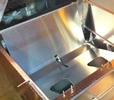

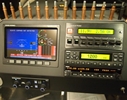
random user submitted photo
The VeeCU
Re: The VeeCU
Hey Guys,
I got some time in on the project.
I drained the fuel and donated it to my lawn mower. Inserted the FF transducer into the fuel system, got 5 gal of fresh fuel, and calibrated the FF. I left the gascolator (used as a vapor separator) in the system so I could measure FF with fuel injection using a single FF transducer. I also left the original fuel pump in place. I will wait to test the Walbro until I have a variable voltage bench supply so I can see how the capacity of each pump varies with voltage.

I moved most of the switch functions over to the bench and wired the "Central Command" instrument panel. The only control left in the aircraft is the Master Switch which enables the starter to run off of the battery. All other power is provided by the bench supply.

Looking ahead, I will probably implement variable timing first. So, I decided to fashion a pointer to help me watch timing changes. The case has a very convenient place to mount a pointer.
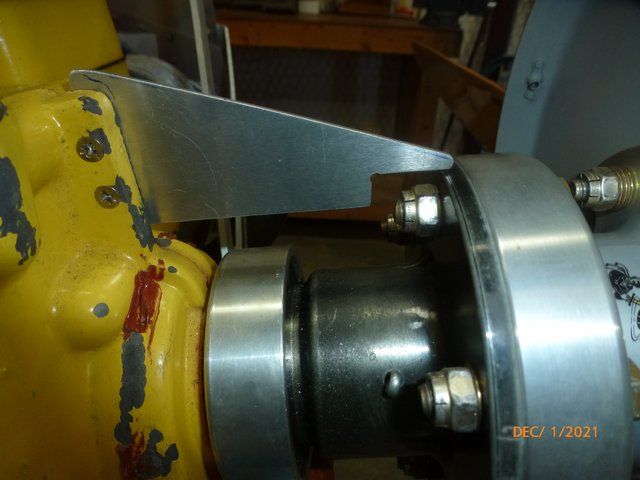
It was at that point that I realized that I wouldn't be able to see the pointer from a safe position so I remade the top of the cooling shroud from Lexan so I could safely observe a timing light.
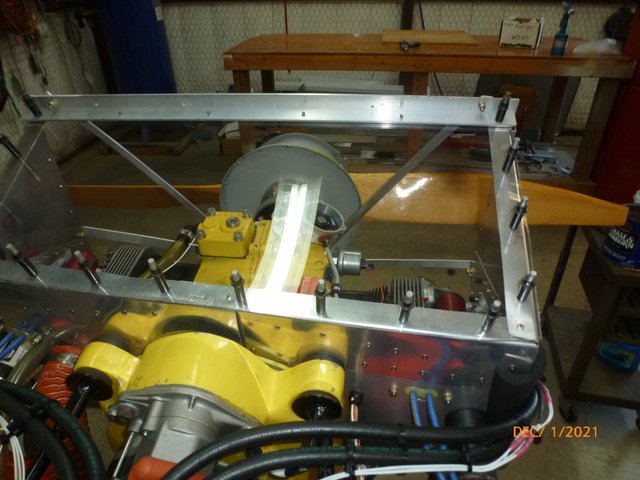
I plumed and wired all of the fuel injectors. I also plumed manifold pressure to both the EIS MAP transducer and the fuel pressure regulator. I pressurized the fuel system. No runs, no drips, now errors. A lot of FI hose. Seems like a fuel rail might be neater.
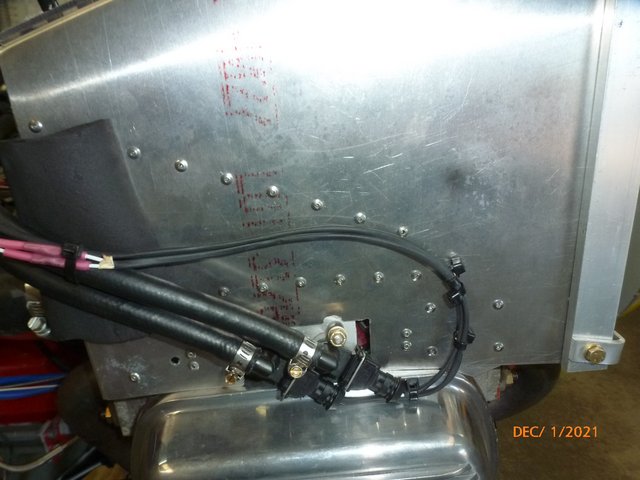
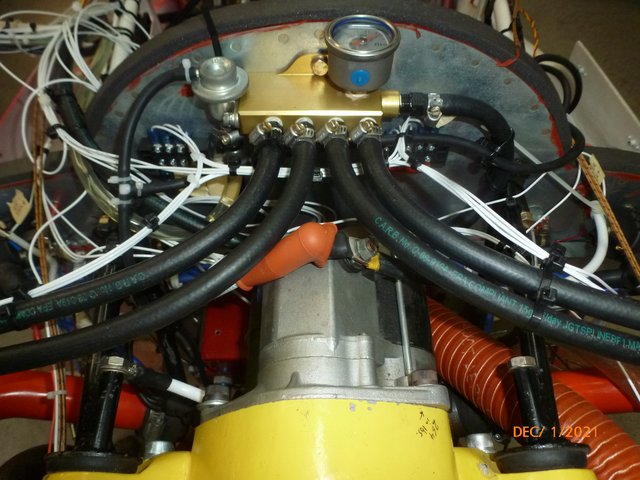
I added fuel and fired the engine to make sure I hadn't introduced any severe manifold leaks. All good there. I got to see the 02 (Mixture) gauge work for the first time. Very noisy and a very lean indication at idle. That is probably due to misfires rather than an induction leak. The indication settles down as throttle is added.
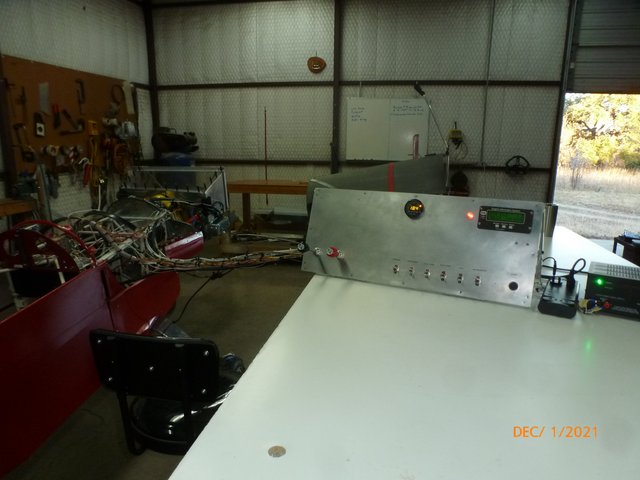
All of the pertinent signals have been wired to the bench ready for use.
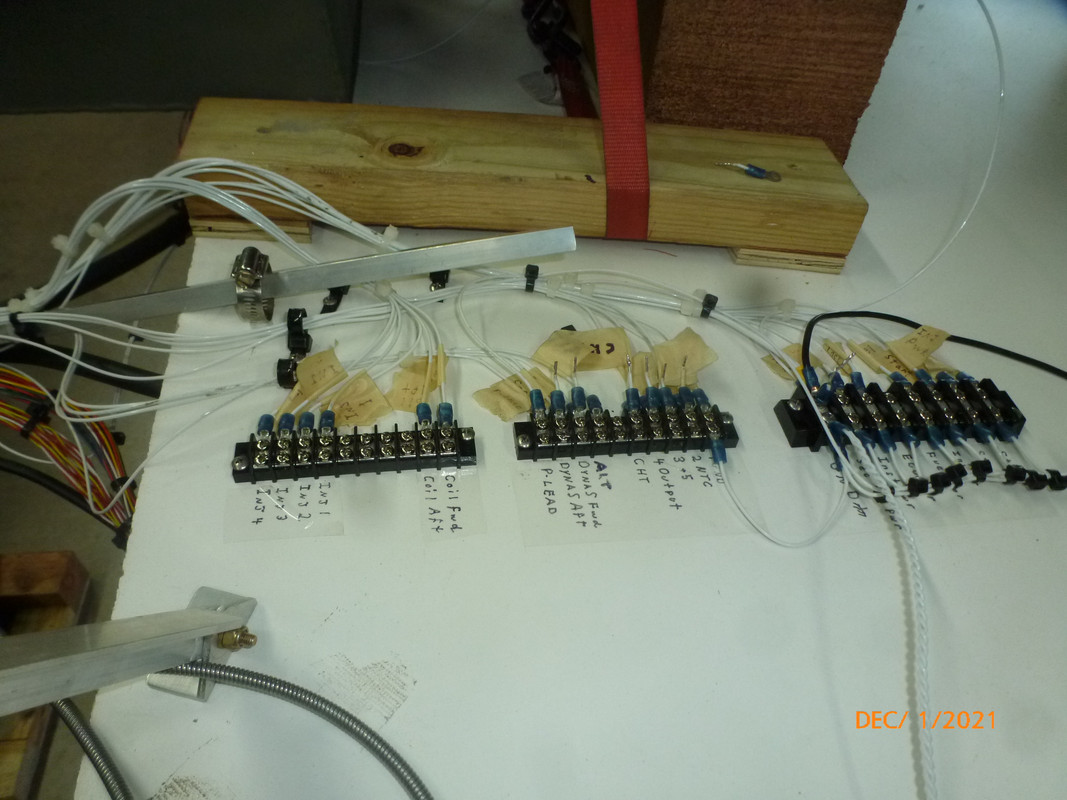
Really the only thing I need to add to the test bed is a timing light. I'll probably install it in the timing shroud so it's easy to turn on and use.
Just about out of excuses. Going to have to switch back to electronics soon. Oh yes, I have a low oil pressure indication of approximately 20 PSI at power. Swapped sensors with identical results. I might try one of these: https://www.jbugs.com/product/9198.html?utm_content=shopping&gclid=EAIaIQobChMIp6zS0urD9AIVxStMCh2zuwtAEAQYAiABEgLb3_D_BwE
I also need to go through the EIS as make sure the limits are set properly.
Forever Forward,
Wes
I got some time in on the project.
I drained the fuel and donated it to my lawn mower. Inserted the FF transducer into the fuel system, got 5 gal of fresh fuel, and calibrated the FF. I left the gascolator (used as a vapor separator) in the system so I could measure FF with fuel injection using a single FF transducer. I also left the original fuel pump in place. I will wait to test the Walbro until I have a variable voltage bench supply so I can see how the capacity of each pump varies with voltage.

I moved most of the switch functions over to the bench and wired the "Central Command" instrument panel. The only control left in the aircraft is the Master Switch which enables the starter to run off of the battery. All other power is provided by the bench supply.

Looking ahead, I will probably implement variable timing first. So, I decided to fashion a pointer to help me watch timing changes. The case has a very convenient place to mount a pointer.

It was at that point that I realized that I wouldn't be able to see the pointer from a safe position so I remade the top of the cooling shroud from Lexan so I could safely observe a timing light.

I plumed and wired all of the fuel injectors. I also plumed manifold pressure to both the EIS MAP transducer and the fuel pressure regulator. I pressurized the fuel system. No runs, no drips, now errors. A lot of FI hose. Seems like a fuel rail might be neater.


I added fuel and fired the engine to make sure I hadn't introduced any severe manifold leaks. All good there. I got to see the 02 (Mixture) gauge work for the first time. Very noisy and a very lean indication at idle. That is probably due to misfires rather than an induction leak. The indication settles down as throttle is added.

All of the pertinent signals have been wired to the bench ready for use.

Really the only thing I need to add to the test bed is a timing light. I'll probably install it in the timing shroud so it's easy to turn on and use.
Just about out of excuses. Going to have to switch back to electronics soon. Oh yes, I have a low oil pressure indication of approximately 20 PSI at power. Swapped sensors with identical results. I might try one of these: https://www.jbugs.com/product/9198.html?utm_content=shopping&gclid=EAIaIQobChMIp6zS0urD9AIVxStMCh2zuwtAEAQYAiABEgLb3_D_BwE
I also need to go through the EIS as make sure the limits are set properly.
Forever Forward,
Wes
Wes Ragle
Onex #89
Conventional Gear
Long Tips
Hummel 2400 w/Zenith Carb
Prince P Tip 54x50
First Flight 06/23/2020
42.8 Hrs. as of 10/30/21
Onex #89
Conventional Gear
Long Tips
Hummel 2400 w/Zenith Carb
Prince P Tip 54x50
First Flight 06/23/2020
42.8 Hrs. as of 10/30/21
- WesRagle
- Posts: 900
- Joined: Fri Jan 05, 2018 12:35 pm
- Location: Weatherford, Tx
Re: The VeeCU
Onwards to infinity Wes!!!
Graeme says flux gates are on backorder…so keep hacking.
Following…far behind. Gordon
Graeme says flux gates are on backorder…so keep hacking.
Following…far behind. Gordon
Waiex 158 New York. N88YX registered.
3.0 Liter Corvair built, run, and installed.
Garmin panel, Shorai LiFePo batteries.
3.0 Liter Corvair built, run, and installed.
Garmin panel, Shorai LiFePo batteries.
- GordonTurner
- Posts: 669
- Joined: Tue Feb 21, 2012 1:14 am
- Location: NY, NY
Re: The VeeCU
Hey Gordon,
I believe it's out of production. Per O'Reilly, "This item is not available for purchase". I picked up the last one:-) Rumor is that ACS will have some in "New Old Stock" soon.
Wes
GordonTurner wrote:Graeme says flux gates are on backorder…so keep hacking.
I believe it's out of production. Per O'Reilly, "This item is not available for purchase". I picked up the last one:-) Rumor is that ACS will have some in "New Old Stock" soon.
Wes
Wes Ragle
Onex #89
Conventional Gear
Long Tips
Hummel 2400 w/Zenith Carb
Prince P Tip 54x50
First Flight 06/23/2020
42.8 Hrs. as of 10/30/21
Onex #89
Conventional Gear
Long Tips
Hummel 2400 w/Zenith Carb
Prince P Tip 54x50
First Flight 06/23/2020
42.8 Hrs. as of 10/30/21
- WesRagle
- Posts: 900
- Joined: Fri Jan 05, 2018 12:35 pm
- Location: Weatherford, Tx
Re: The VeeCU
WesRagle wrote:I believe it's out of production. Per O'Reilly, "This item is not available for purchase". I picked up the last one:-) Rumor is that ACS will have some in "New Old Stock" soon.
Wes
We had a 182 and engine out at a local airport a couple of years ago. The reporter got the inside scoop....
Graeme JW Smith
-

GraemeSmith - Posts: 939
- Joined: Sat May 18, 2019 8:58 am
- Location: RI
Re: The VeeCU
Hi Guys,
Just about finished with the test setup.
I jumped the trigger on my old timing light and strapped it to the top of the cooling shroud.
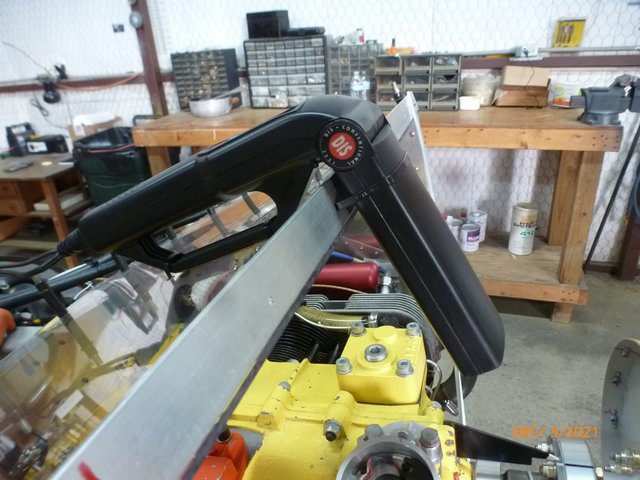
I checked the mag timing and it was dead on. I added a 3 Deg. after TDC mark and adjusted the secondary timing to 3 Deg. after TDC.
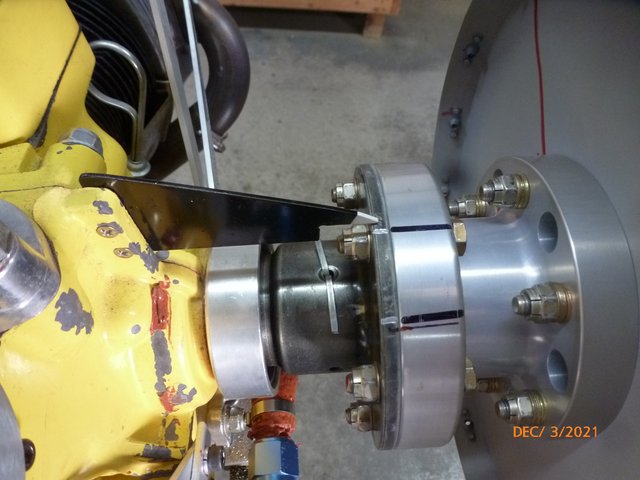
As expected, the engine starts easier but even at idle runs like crap on the secondary.
I couldn't resist running the engine some to get my feet on the ground. I anticipate that the initial fuel map will be generated by running on the RevFlow, leaning to peak power, and dividing FF by 4 to calculate injector pulse width. So, I wanted to work vernier mixture control some and see how the A/F indication and engine parameters responded. I was surprised at the amount of fuel savings available and how sensitive the mixture control is as the engine starts to lean. Here are a couple of data points. Left to Right, Top to Bottom: RPM MAP FF Oil Temp/Oil Pressure CHT/EGT
Full Rich:


Just Rich of Rough:
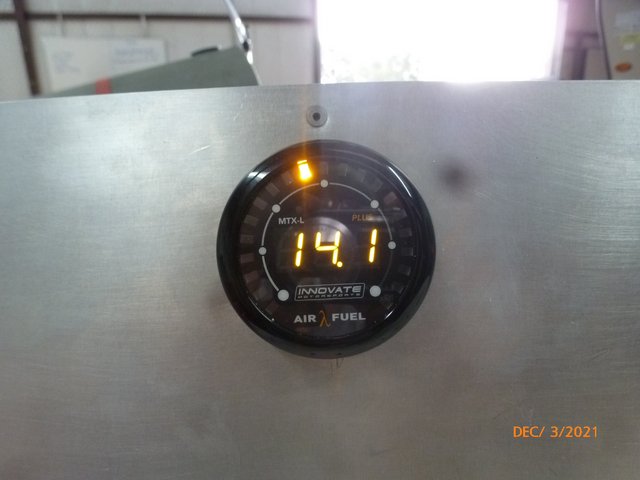
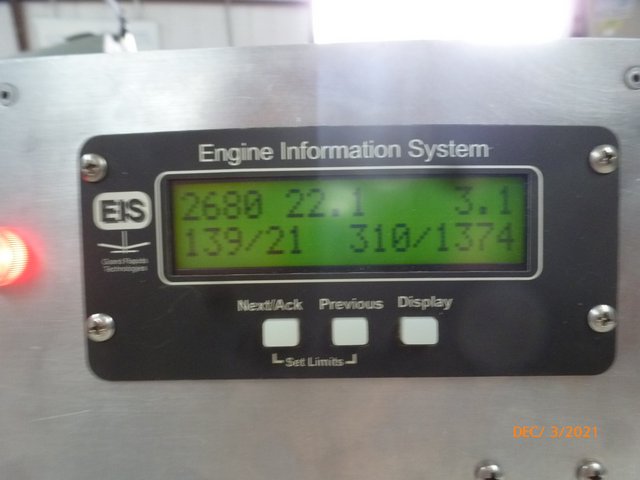
I forgot to check the EGT spread :-( Oh well, there will be plenty of time for that. At the end of the run I did return the mixture to full rich and the CHTs started dropping indicating that the cooling shroud will be sufficient. The Oil Pressure adjustment gizmo is on order.
Wes
Just about finished with the test setup.
I jumped the trigger on my old timing light and strapped it to the top of the cooling shroud.

I checked the mag timing and it was dead on. I added a 3 Deg. after TDC mark and adjusted the secondary timing to 3 Deg. after TDC.

As expected, the engine starts easier but even at idle runs like crap on the secondary.
I couldn't resist running the engine some to get my feet on the ground. I anticipate that the initial fuel map will be generated by running on the RevFlow, leaning to peak power, and dividing FF by 4 to calculate injector pulse width. So, I wanted to work vernier mixture control some and see how the A/F indication and engine parameters responded. I was surprised at the amount of fuel savings available and how sensitive the mixture control is as the engine starts to lean. Here are a couple of data points. Left to Right, Top to Bottom: RPM MAP FF Oil Temp/Oil Pressure CHT/EGT
Full Rich:


Just Rich of Rough:


I forgot to check the EGT spread :-( Oh well, there will be plenty of time for that. At the end of the run I did return the mixture to full rich and the CHTs started dropping indicating that the cooling shroud will be sufficient. The Oil Pressure adjustment gizmo is on order.
Wes
Wes Ragle
Onex #89
Conventional Gear
Long Tips
Hummel 2400 w/Zenith Carb
Prince P Tip 54x50
First Flight 06/23/2020
42.8 Hrs. as of 10/30/21
Onex #89
Conventional Gear
Long Tips
Hummel 2400 w/Zenith Carb
Prince P Tip 54x50
First Flight 06/23/2020
42.8 Hrs. as of 10/30/21
- WesRagle
- Posts: 900
- Joined: Fri Jan 05, 2018 12:35 pm
- Location: Weatherford, Tx
Re: The VeeCU
I have followed along for a bit, but I now have to chime in: WOW!! What a great undertaking, and I really appreciate your methodolgy and process! Again , WOW!!
And I do think a fuel rail would be better, but the proof of performance of your design and process would not be altered very much from what it is now if a fuel rail is used.
I am intrigued with the F/A mixture system you have, and wonder if it is applicable to non injected engines> I did have one on a truck many years ago, but was not pleased with it. Should I assume you use O2 sensors, in just one stack, or do you have some other setup?
Again, WOW, I am impressed, Wes! Carry on!!!
And I do think a fuel rail would be better, but the proof of performance of your design and process would not be altered very much from what it is now if a fuel rail is used.
I am intrigued with the F/A mixture system you have, and wonder if it is applicable to non injected engines> I did have one on a truck many years ago, but was not pleased with it. Should I assume you use O2 sensors, in just one stack, or do you have some other setup?
Again, WOW, I am impressed, Wes! Carry on!!!
Joe Nelsen
scratch built :D
Sirpeedee, N502PD, s/n 1510, Aero Vee 2.1 s/n 0870,
ADS-B in (Stratux)/out(SkyBeacon)
Flying @81.7
KGYI/N. Tx Reg/Perrin Field
EAA Technical Counselor, Chapter 323, Sherman, TX
scratch built :D
Sirpeedee, N502PD, s/n 1510, Aero Vee 2.1 s/n 0870,
ADS-B in (Stratux)/out(SkyBeacon)
Flying @81.7
KGYI/N. Tx Reg/Perrin Field
EAA Technical Counselor, Chapter 323, Sherman, TX
-

n502pd - Posts: 380
- Joined: Sat Feb 23, 2013 12:13 am
- Location: Gunter, Texas
Re: The VeeCU
HI Joe,
Thanks. I'm having fun with it. But ..., I haven't really done anything yet. I'm just fix'in to begin to start to get ready to do something. I woke up this morning with visions of sugar plums dancing in my head but soon realized that I'm not finished with the test bed yet. When I started thinking about patching the various boards together and testing concepts I came to the part where I had to wire to the terminal strip. That's not going to work. I need an interface panel so I can unplug, modify, plug back in, and test.
The old O2 sensors weren't very good. They switched quickly from rich to lean indication at stoichiometric. The newer wide band sensors have a much less abrupt transition and so can be used to read the A/F ration. The system I'm using is made by "Innovate" and is readily available. The sensors are not compatible with leaded fuel.
I have a bung in each stack but right now I'm just reading the right stack. The reading is still a little noisy but that's no different than what I've seen on YouTube videos. It might be that I have the sensor too close to the end of the exhaust pipe and my exhaust gasses are being polluted with fresh air :-).
Wes
Thanks. I'm having fun with it. But ..., I haven't really done anything yet. I'm just fix'in to begin to start to get ready to do something. I woke up this morning with visions of sugar plums dancing in my head but soon realized that I'm not finished with the test bed yet. When I started thinking about patching the various boards together and testing concepts I came to the part where I had to wire to the terminal strip. That's not going to work. I need an interface panel so I can unplug, modify, plug back in, and test.
n502pd wrote:I am intrigued with the F/A mixture system you have, and wonder if it is applicable to non injected engines> I did have one on a truck many years ago, but was not pleased with it.
The old O2 sensors weren't very good. They switched quickly from rich to lean indication at stoichiometric. The newer wide band sensors have a much less abrupt transition and so can be used to read the A/F ration. The system I'm using is made by "Innovate" and is readily available. The sensors are not compatible with leaded fuel.
n502pd wrote:Should I assume you use O2 sensors, in just one stack, or do you have some other setup?
I have a bung in each stack but right now I'm just reading the right stack. The reading is still a little noisy but that's no different than what I've seen on YouTube videos. It might be that I have the sensor too close to the end of the exhaust pipe and my exhaust gasses are being polluted with fresh air :-).
Wes
Wes Ragle
Onex #89
Conventional Gear
Long Tips
Hummel 2400 w/Zenith Carb
Prince P Tip 54x50
First Flight 06/23/2020
42.8 Hrs. as of 10/30/21
Onex #89
Conventional Gear
Long Tips
Hummel 2400 w/Zenith Carb
Prince P Tip 54x50
First Flight 06/23/2020
42.8 Hrs. as of 10/30/21
- WesRagle
- Posts: 900
- Joined: Fri Jan 05, 2018 12:35 pm
- Location: Weatherford, Tx
Re: The VeeCU
WesRagle wrote:The VeeCU will intercept the ignition pulses coming from the secondary ignition module and use those pulses, in lieu of a crank sensor
I'm just getting caught up on this interesting thread. Check out how these guys picked up timing from an equally old engine design. Go to 10:20 https://www.youtube.com/watch?v=HKIjsXUMvhc
- Zack
- Posts: 75
- Joined: Fri Nov 24, 2017 11:45 am
Re: The VeeCU
Hi Zack,
That was interesting. I watched the whole thing. What'da'you think? $250,000 for that engine? I wish that guy would spend a little on us and develop a casting for a good universal FI ready intake log :-)
When I first started thinking about fuel injection I was interested in sequential FI. The only CAM sensor I could find was this: https://thedubshop.com/mini-cam-sync/. The more I read the more I became convinced that sequential isn't needed for an aircraft application. As I understand it the automotive market was driven to sequential FI to meet emission requirements. The idea is to always inject fuel against a hot, closed, intake valve, just before the intake stroke, to better vaporize the fuel and help with hydrocarbon emissions. Not sure though.
Using the secondary ignition pulses at least gives the opportunity to implement true semi-sequential injection. The injectors I installed will operate at just below 50% duty cycle at 100% power. So, I can inject twice on either the up strokes or the down strokes. One of the experiments I look forward to conducting is switching between those options. If I inject twice against a closed intake valve will it help with cylinder head cooling? If I inject once against a closed intake valve and once on the intake stroke will the intake stroke injection help cool the charge and improve cylinder filling? I don't know. It may make no difference at all but it will be fun to find out.
Wes
That was interesting. I watched the whole thing. What'da'you think? $250,000 for that engine? I wish that guy would spend a little on us and develop a casting for a good universal FI ready intake log :-)
When I first started thinking about fuel injection I was interested in sequential FI. The only CAM sensor I could find was this: https://thedubshop.com/mini-cam-sync/. The more I read the more I became convinced that sequential isn't needed for an aircraft application. As I understand it the automotive market was driven to sequential FI to meet emission requirements. The idea is to always inject fuel against a hot, closed, intake valve, just before the intake stroke, to better vaporize the fuel and help with hydrocarbon emissions. Not sure though.
Using the secondary ignition pulses at least gives the opportunity to implement true semi-sequential injection. The injectors I installed will operate at just below 50% duty cycle at 100% power. So, I can inject twice on either the up strokes or the down strokes. One of the experiments I look forward to conducting is switching between those options. If I inject twice against a closed intake valve will it help with cylinder head cooling? If I inject once against a closed intake valve and once on the intake stroke will the intake stroke injection help cool the charge and improve cylinder filling? I don't know. It may make no difference at all but it will be fun to find out.
Wes
Wes Ragle
Onex #89
Conventional Gear
Long Tips
Hummel 2400 w/Zenith Carb
Prince P Tip 54x50
First Flight 06/23/2020
42.8 Hrs. as of 10/30/21
Onex #89
Conventional Gear
Long Tips
Hummel 2400 w/Zenith Carb
Prince P Tip 54x50
First Flight 06/23/2020
42.8 Hrs. as of 10/30/21
- WesRagle
- Posts: 900
- Joined: Fri Jan 05, 2018 12:35 pm
- Location: Weatherford, Tx
Re: The VeeCU
It's a great show, and like an apprentice of old you can pick up some interesting things watching a master at work.
I think the reason for sequential FI is quicker response to changing conditions (RPM, manifold pressure) in an automotive application. I think you're right, it's not needed for an aircraft application. I look forward to your testing!
I think the reason for sequential FI is quicker response to changing conditions (RPM, manifold pressure) in an automotive application. I think you're right, it's not needed for an aircraft application. I look forward to your testing!
- Zack
- Posts: 75
- Joined: Fri Nov 24, 2017 11:45 am
Who is online
Users browsing this forum: No registered users and 1 guest







